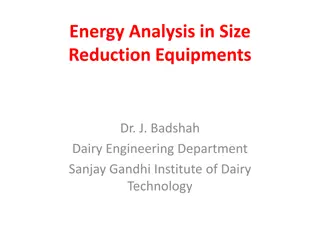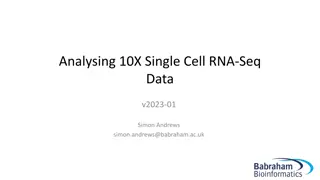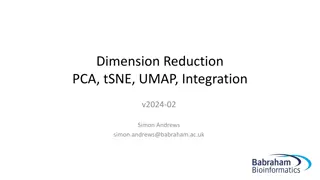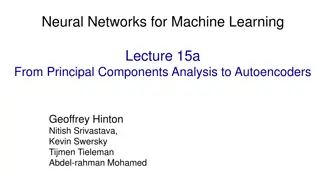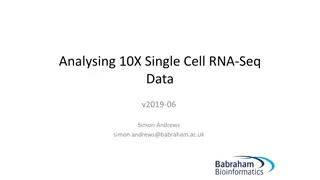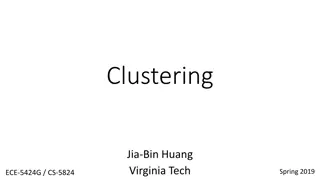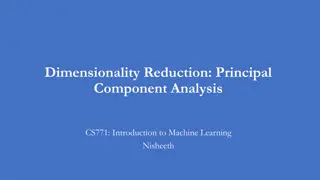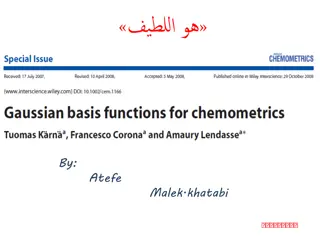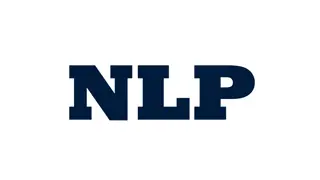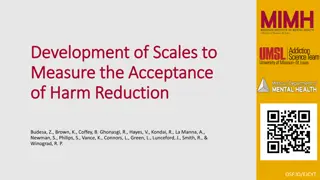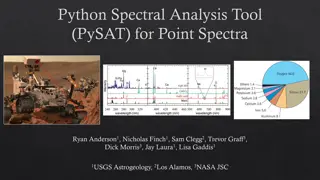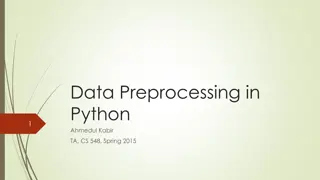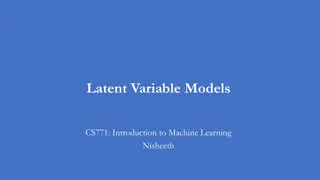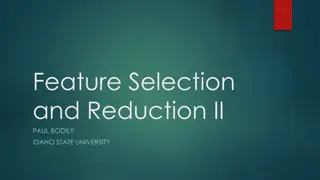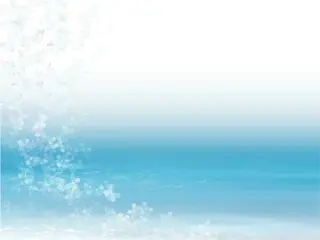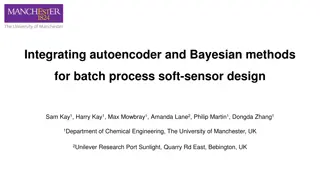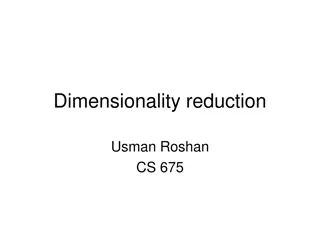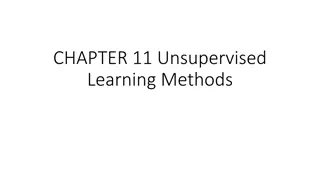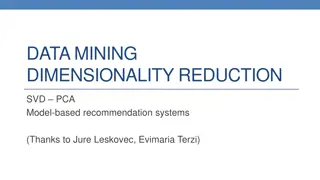Historic Investments in Climate Action: Inflation Reduction Act May 2023
The Inflation Reduction Act (IRA) of May 2023 focuses on making significant investments in climate action to reduce U.S. emissions by an estimated 40% by 2030. This act supports disadvantaged communities, the clean energy industry, and aims to drive emissions reductions over the next decade while pa
10 views • 14 slides
Comprehensive Overview of Autoencoders and Their Applications
Autoencoders (AEs) are neural networks trained using unsupervised learning to copy input to output, learning an embedding. This article discusses various types of autoencoders, topics in autoencoders, applications such as dimensionality reduction and image compression, and related concepts like embe
10 views • 86 slides
Harm Reduction in Addiction Psychiatry: A Comprehensive Overview
Harm reduction in addiction psychiatry is a client-centered approach that focuses on reducing negative consequences associated with substance use. This philosophy involves practical strategies and principles aimed at promoting safer drug use practices. The historical background traces the evolution
8 views • 40 slides
Techniques of Fracture Reduction in Veterinary Medicine
Explore the techniques of fracture reduction in veterinary surgery, including closed reduction and toggling method, explained by Dr. Archana Kumari. Learn about the advantages of closed reduction, indications for treatment, and the step-by-step technique involved in reducing fractures in animals. Di
3 views • 14 slides
Energy Analysis in Size Reduction Equipments
This comprehensive overview delves into the energy analysis involved in size reduction equipment, exploring topics such as objectives of size reduction units, sieve analysis for particle size distribution, mesh number system, and mathematical models for energy analysis in size reduction units. Dr. J
4 views • 11 slides
10X Single Cell RNA-Seq Analysis
This content delves into the intricacies of analyzing 10X single-cell RNA-Seq data, covering topics such as how 10X RNA-Seq works, evaluating CellRanger QC reports, dimensionality reduction techniques like PCA, tSNE, and UMAP, using the Loupe cell browser, and frameworks for scRNA analysis in R. It
3 views • 39 slides
Dimension Reduction Techniques in Data Analysis
Employing techniques like PCA, tSNE, and UMAP allows for effective visualization and integration of multi-dimensional datasets. These methods help in reducing data complexity to reveal patterns and insights for further analysis. Gene expression data is used as an example to illustrate the principles
5 views • 43 slides
Principal Components Analysis (PCA) and Autoencoders in Neural Networks
Principal Components Analysis (PCA) is a technique that extracts important features from high-dimensional data by finding orthogonal directions of maximum variance. It aims to represent data in a lower-dimensional subspace while minimizing reconstruction error. Autoencoders, on the other hand, are n
7 views • 35 slides
Analysing 10X Single-Cell RNA-Seq Data
Explore the intricacies of analyzing 10X Single-Cell RNA-Seq data, from how the technology works to using tools like CellRanger, Loupe Cell Browser, and Seurat in R. Learn about the process of generating barcode counts, mapping, filtering, quality control, and quantitation of libraries. Dive into di
5 views • 34 slides
Overview of Unsupervised Learning in Machine Learning
This presentation covers various topics in unsupervised learning, including clustering, expectation maximization, Gaussian mixture models, dimensionality reduction, anomaly detection, and recommender systems. It also delves into advanced supervised learning techniques, ensemble methods, structured p
3 views • 37 slides
Dimensionality Reduction and Principal Component Analysis
Dimensionality reduction techniques like Principal Component Analysis (PCA) help in transforming high-dimensional data into a lower-dimensional space, leading to efficient storage and better understanding of underlying patterns. By capturing maximum variance in the data, PCA learns projection direct
9 views • 16 slides
Learning-Based Low-Rank Approximations and Linear Sketches
Exploring learning-based low-rank approximations and linear sketches in matrices, including techniques like dimensionality reduction, regression, and streaming algorithms. Discusses the use of random matrices, sparse matrices, and the concept of low-rank approximation through singular value decompos
3 views • 13 slides
Functional Approximation Using Gaussian Basis Functions for Dimensionality Reduction
This paper proposes a method for dimensionality reduction based on functional approximation using Gaussian basis functions. Nonlinear Gauss weights are utilized to train a least squares support vector machine (LS-SVM) model, with further variable selection using forward-backward methodology. The met
4 views • 23 slides
Semantic Concepts in Natural Language Processing
Explore the world of Natural Language Processing (NLP) through images and explanations, covering topics such as text similarity, dimensionality reduction, semantic matching, and the challenges with vector similarity. Dive into the concept space, TOEFL synonyms, SAT analogies, and the importance of r
3 views • 39 slides
Electrochemical Reduction of CO2 on Copper and Mixed Metal Oxides
Different methods for CO2 reduction have been studied, with electrochemical reduction showing promise due to its use of electricity from nonconventional sources. Research on copper's unique characteristics for producing various CO2 reduction products has led to investigations into optimizing activit
1 views • 30 slides
Development and Evaluation of Harm Reduction Acceptance Scales
Development of scales to measure the acceptance of harm reduction is crucial for understanding public attitudes towards harm reduction strategies. This project focuses on creating valid and reliable scales through a systematic process involving item development, data collection, analysis, and refine
4 views • 15 slides
PySAT Point Spectra Tool: Spectral Analysis and Regression Software
PySAT is a Python-based spectral analysis tool designed for point spectra processing and regression tasks. It offers various features such as preprocessing, data manipulation, multivariate regression, K-fold cross-validation, plotting capabilities, and more. The tool's modular interface allows users
2 views • 6 slides
Integrating Climate Change Adaptation in Disaster Risk Reduction Module 1
Welcome to the e-Learning module on integrating climate change adaptation in disaster risk reduction. This module covers concepts in disaster risk reduction and climate change adaptation. It is part of a package that includes five modules focusing on vulnerability, disaster risk reduction, climate c
1 views • 29 slides
Data Preprocessing Techniques in Python
This article covers various data preprocessing techniques in Python, including standardization, normalization, missing value replacement, resampling, discretization, feature selection, and dimensionality reduction using PCA. It also explores Python packages and tools for data mining, such as Scikit-
5 views • 14 slides
Latent Variable Models in Machine Learning
Latent variable models play a crucial role in machine learning, especially in unsupervised learning tasks like clustering, dimensionality reduction, and probability density estimation. These models involve hidden variables that encode latent properties of observations, allowing for a deeper insight
4 views • 10 slides
Feature Selection and Reduction Techniques Using PCA
In machine learning, Principal Components Analysis (PCA) is a common method for dimensionality reduction. It helps combine information from multiple features into a smaller set, focusing on directions of highest variance to eliminate noise in the data. PCA is unsupervised and works well with linear
0 views • 18 slides
Projection Methods in Chemistry: A Survey of Linear and Nonlinear Techniques
Visualization and interpretation of high-dimensional data structures in chemistry can be achieved through projection techniques. Linear projection methods like PCA and Pursuit Projection allow for dimensionality reduction and clustering tendency exploration. The Intent Pursuit Projection (PP) techni
0 views • 26 slides
Understanding KPI Trade-offs in Modelling Architectures and Data Acquisition
Explore the key challenges and trade-offs involved in modeling architectures and data acquisition, as discussed in the works of Gerald Gurtner and Andrew Cook. The content delves into the complexities of trade-offs, goals, and objectives in the aviation industry, specifically focusing on the Vista p
2 views • 27 slides
Factor Analysis
Factor analysis is a statistical method used to identify underlying factors that explain correlations among variables. It helps in reducing large datasets by finding uncorrelated variables. There are two types of factor analysis: Exploratory Factor Analysis (EFA) and Confirmatory Factor Analysis (CF
3 views • 18 slides
Factor and Principle Component Analysis
Variable reduction methods like Factor and Principle Component Analysis help in combining correlated variables to reduce dimensionality and maximize information. Standardizing data and identifying underlying factors are key steps in consolidating multiple variables and understanding correlations in
0 views • 24 slides
Approximately Learning: Noise, Model Selection, Dimensionality Reduction
In Module II, explore Probably Approximately Learning (PAC), Noise, Model Selection, and Generalization. Understand the impact of noise on data, the sources of noise, and how noise affects learning outcomes. Discover methods like Principal Component Analysis and subset selection to address noise in
4 views • 133 slides
Linear Discriminant Analysis in Dimensionality Reduction
Linear Discriminant Analysis (LDA) is a technique used to project a high-dimensional feature space onto a lower-dimensional space while maintaining class separation. By focusing on means and finding dimensions that separate them effectively, LDA helps reduce computational costs and minimize overfitt
1 views • 37 slides
Learning Concepts for Text Similarity Projections
Explore discriminative projections for text similarity measures, cross-language document retrieval, and web search advertising. Discover the vector space model, ideal mapping, and various dimensionality reduction methods like S2Net and PCA.
0 views • 28 slides
Soft Sensor Design Using Autoencoder and Bayesian Methods
Explore the integration of autoencoder and Bayesian methods for batch process soft sensor design, focusing on viscosity estimation in complex liquid formulations. The methodology involves investigating process data, dimensionality reduction with autoencoder, and developing nonlinear estimators for v
1 views • 17 slides
Substance Use Harm Reduction Strategies in Medical Care
Promote the adoption of practical harm reduction strategies to address the negative effects of substance use in medical care. The guidelines recommend offering medical care, harm reduction counseling, and collaborating with patients to set harm reduction goals. Clinicians are advised to educate pati
0 views • 14 slides
Dimensionality Reduction Techniques and Applications
Explore the concept of dimensionality reduction, its importance in handling high-dimensional data, and key techniques such as Principal Component Analysis (PCA) and Singular Vector Decomposition (SVD). Learn how reducing dimensions can alleviate the curse of dimensionality, eliminate noise, and enha
3 views • 37 slides
Effective Strategies for Handling High-Dimensional Data in Large-Scale Networks
Explore considerations for managing high-dimensional data in large-scale network settings, including challenges, solutions, and the impact of network effects on data analysis. Learn about dimensionality reduction, propensity score estimation, language model comparisons, and dealing with interference
3 views • 17 slides
Linear Discriminant Analysis for Dimensionality Reduction
Explore the concept of Linear Discriminant Analysis (LDA) as a supervised dimensionality reduction technique. Learn how LDA maximizes the ratio of difference means to the sum of variance, utilizing scatter matrices and Fisher linear discriminant solutions for improved data separation.
2 views • 30 slides
Unsupervised Learning: Dimensionality Reduction and Clustering Methods
Explore unsupervised learning methods such as dimensionality reduction and clustering to transform data and discover patterns without explicit labels. Learn about techniques like Principal Component Analysis (PCA) for reducing dimensions and addressing the curse of dimensionality.
15 views • 63 slides
Unsupervised Learning: Understanding Topic Modeling
Dive into the world of unsupervised learning with topic modeling, where documents are analyzed to uncover hidden topics. Explore how algorithms process data, create topic representations, and measure document similarity. Discover the importance of document-term matrices and dimensionality reduction
5 views • 10 slides
Dimensionality Reduction Techniques in Data Mining
Explore the concept of dimensionality reduction in data mining, where high-dimensional data poses challenges, leading to the curse of dimensionality. Techniques like PCA and SVD help overcome these challenges by reducing dimensions while retaining essential information. Case examples illustrate the
2 views • 71 slides
Data Mining Dimensionality Reduction Techniques Explained
Understand how the curse of dimensionality impacts data analysis, the importance of dimensionality reduction in managing high-dimensional data, and examples of reducing dimensionality for efficient data processing and analysis. Learn from real-world scenarios and expert recommendations.
3 views • 78 slides
Dimensionality Reduction Analysis for Multivariate Data: Methods and Techniques
Explore dimensionality reduction techniques to simplify complex multivariate data, including feature selection and extraction methods. Enhance visualization and reduce time complexity efficiently." (Characters: 213)
2 views • 58 slides
Unsupervised Learning Methods: Dimensionality Reduction, Clustering, Frequent Pattern Mining
Explore the world of unsupervised learning methods in this chapter, where the focus shifts from predicting to transforming data and discovering patterns without explicit training labels. Dive into dimensionality reduction techniques like Principal Component Analysis to simplify datasets and avoid th
1 views • 63 slides
Understanding Principal Component Analysis: Key Concepts and Applications
Explore the underlying concepts and practical applications of Principal Component Analysis (PCA) in data processing, feature extraction, and dimensionality reduction. Learn how PCA helps in efficiently representing data and identifying patterns for tasks like classification, visualization, and noise
2 views • 20 slides




